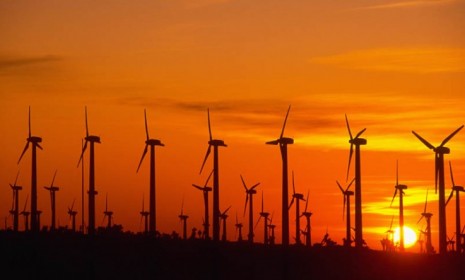Do wind farms actually cause climate change?
A new study suggests that green-energy-creating windmills make the air they're stirring significantly warmer

Here's a curveball on climate change: New research published in the journal Nature Climate Change suggests that large wind farms might have a warming effect on the local climate. Many countries are rapidly expanding their capacity to generate electricity using wind-driven turbines as they try to cut emissions of carbon dioxide and other greenhouse gases created by the burning of fossil fuels. But are wind farms contributing to the very problem they're supposed to help solve? Here, a brief guide:
How much do wind farms heat up the air?
Researchers at the State University of New York at Albany looked at satellite data from 2003 to 2011 across a wide swath of West Texas, where four of the world's largest wind farms were built during that period. Night-time temperatures in the air above the wind-power facilities were 1.3 degrees higher than in other areas. "We attribute this warming primarily to wind farms," say the authors of the study.
The Week
Escape your echo chamber. Get the facts behind the news, plus analysis from multiple perspectives.

Sign up for The Week's Free Newsletters
From our morning news briefing to a weekly Good News Newsletter, get the best of The Week delivered directly to your inbox.
From our morning news briefing to a weekly Good News Newsletter, get the best of The Week delivered directly to your inbox.
What accounts for the warming?
Normally, temperatures drop after the sun sets, as cooler air settles on the ground. But windmills create turbulence that stirs up that chilly air, mixing it with a warmer layer on top and preventing temperatures from falling as much as they otherwise would. These findings confirm previous research in 2010 that found windmills can make nights warmer and days cooler in the area immediately around them.
So the problem is local, not global?
Yes. But wind farms cover more and more vast stretches of land every day. The world's wind-power capacity jumped 21 percent last year, and is expected to grow from 238 gigawatts of electricity at any one time to 500 gigawatts by the end of 2016 as more wind farms are built.
A free daily email with the biggest news stories of the day – and the best features from TheWeek.com
Is this really so bad?
It's certainly not as bad as man-made warming that prompted the push to use wind, solar, and other forms of green energy in the first place. But it's also not without its costs. Consider West Texas, which went from 111 windmills in 2003 to 2,358 in 2011. Rising temperatures risk compounding problems such as a brutal drought the region has experienced over the last few years, which could have devastating effects on agriculture.
What's the solution?
Researchers see two ways to prevent the phenomenon from doing much damage. One is reducing the size of windmill blades so they don't stir up the air as much. But of course, smaller turbine blades would generate less power. Another option is locating new wind farms in areas with considerable air turbulence so the windmills wouldn't do anything to thermal layers that Mother Nature isn't already doing herself.
Sources: Discovery News, Reuters, Telegraph
-
 What new cryptocurrency regulations mean for investors
What new cryptocurrency regulations mean for investorsThe Explainer The Treasury and the Financial Conduct Authority aim to make the UK a more attractive and safer place for crypto assets
-
 The Salt Path Scandal: an ‘excellent’ documentary
The Salt Path Scandal: an ‘excellent’ documentaryThe Week Recommends Sky film dives back into the literary controversy and reveals a ‘wealth of new details’
-
 AI griefbots create a computerized afterlife
AI griefbots create a computerized afterlifeUnder the Radar Some say the machines help people mourn; others are skeptical